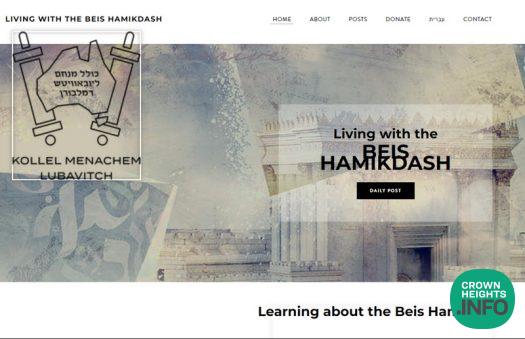
Kollel Inspires on the Spirit of the Beis Hamikdash
During the Three Weeks, the Rebbe strongly encouraged the study about the Beis Hamikdash.
Chassidus brings the teaching that the Mitzvah of building a Beis Hamikdash ועשו לי מקדש ושכנתי בתוכם refers also to the Mikdash inside each one of us. Each element of the design of the Beis Hamikdash, the Keilim and the Avodah, has a parallel in the Neshama and our personal Avodas Hashem.
For the past seven years, Kollel Menachem Lubavitch of Melbourne has produced the “Daily Beis Hamikdash Thought”, a short spiritual life-lesson from the design of the Beis Hamikdash, based on the Chassidus of our Rebbeim.
Close to a thousand subscribers from around the world currently receive the Daily Thought on Whatsapp, with many more views on the dedicated website and other social media. Authored by Rosh Hakollel Rabbi Yonason Johnson, the Daily Thoughts are explained and brought down in such a away that they can be enjoyed by anyone, from members of Anash and Mekuravim alike.
This year’s series focuses on the inner lessons of the Bigdei Kehuna – the priestly garments. A new Thought is available each day, from the 17th of Tammuz until the 15th of Av.
To subscribe: https://chat.whatsapp.com/CpJdBpFrhNRDsyqhdxM4SH or https://chat.whatsapp.com/DejubcFtJDtFCCfvK4EBFx
View all past Thoughts at www.LivingBeisHamikdash.com
Unlike the physical structure, the inner Beis Hamikdash was never destroyed. May the merit of sharing these teachings and strengthening our inner Beis Hamikdash be the catalyst for the rebuilding of the Mikdash Hashlishi.
Sample post #1:
AT THE FOREFRONT OF OUR FOREHEAD
The Tzitz was a golden head-plate that was worn across the Kohen Gadol’s forehead from ear to ear. It was two fingerbreadths in height. Engraved on the Tzitz were the words Kodesh LaHashem – holy to Hashem.
The brain is the seat of the intellectual capabilities of our soul. We use these intellectual capabilities in Davening to meditate on the greatness of Hashem, His transcendence and the secret of His oneness. The objective of these meditations is to flow through to arouse feelings of love and fear of Hashem with which we pray.
With these meditation and emotions, we rise up beyond the world and attain a deep spiritual sense of yearning and connection. But unfortunately, we can’t stay there.
When we finish Davening and enter the challenges of the material world, the deep understandings and emotions that we experienced in our meditations, swiftly fade away. This is represented by the forehead, the bone which covers over the brain, represents a concealment over the intellect.
We might not be able to remain in the same state of deep understanding and feeling throughout the rest of our day. But we can make a firm resolve and commitment to conduct ourselves in accordance with the realisations that we attained during Davening and to keep it in the forefront of our minds.
This resolve is the represented Tzitz, which was worn constantly over the forehead, engraved with the words Kodesh LaHashem. It is the reminder throughout our day, long after we leave the protective cocoon of the Shule, that no matter where we are, we are “holy to Hashem” and are here in this world to serve Him wherever we are and in everything that we do.
~ Based on Sefer Halikutim, Tzemach Tzedek entry Tzitz
Sample post #2
THE NOISY JEW
The hem of the Me’il was decorated with golden bells. The Torah teaches that the sound of these bells “would be heard when he enters the Holy Place before Hashem and when he leaves”.
Normally, the service of Hashem is associated with silence – as taught in the Book of Kings that Hashem is not found in the… the loud noise…, but rather in the soft still voice. So why was it necessary to have the noise of these bells accompany the Kohen Gadol as he came before Hashem?
When a person stands close to their friend they can communicate with a soft whisper. But when one finds themselves calling-out from afar, they need to raise their voice and shout.
The service of the Tzaddikim, who find themselves close to Hashem, is calm and quiet. They do not experience struggle and turbulence and they do not require any major self-transformation.
In contrast, the Baal Teshuvah finds themselves distant from Hashem. They must confront their struggles and challenges as they detach themselves from their former environment and experience, to draw close to Hashem. Their Avodah is a “noisy” one, as they go through a complete self-negation and transformation.
The noise of the bells represents these Baalei Teshuvah; the “noise” that comes from those who find themselves spiritually on the hem and yearn to rise upwards. When the Kohen Gadol entered the Holy, he did so on behalf of all of the Jewish people; not just the silent Tzaddikim, but also the noisy bells.
But on Yom Kippur, when he entered the Holy of Holies, the Kohen Gadol did not wear the golden garments, including the Me’il with its bells. The Holy of Holies is the essence of the soul. On Yom Kippur, the essence of every Jew is revealed. On this level, every Jew is not just close to Hashem, but united with Him in absolute oneness. Since there is no distance, there is no need for noise.
~ Based on Likutei Sichos volume 16 Tetzaveh 2















